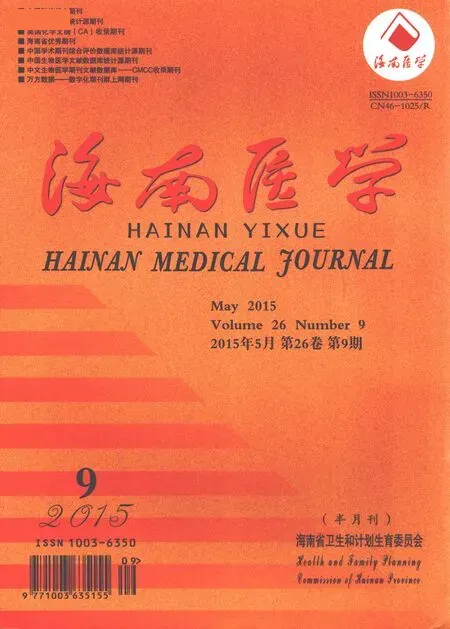胆管癌危险因素研究进展
陈世成,符国珍,周 帅
(海口市人民医院中南大学湘雅附属海口医院肝胆外科,海南 海口 570208)
胆管癌危险因素研究进展
陈世成,符国珍,周 帅
(海口市人民医院中南大学湘雅附属海口医院肝胆外科,海南 海口 570208)
胆管癌(Cholangiocarcinoma)分为肝内胆管癌(ICC)和肝外胆管癌(ECC),ICC和ECC在流行病学、发病机制、临床表现、治疗方法等方面均存在较大差异,胆管癌是恶性程度较高和预后较为不佳的癌症。目前,国内胆管细胞癌的发病率和死亡率呈上升趋势,其原因尚不清楚。现将胆管危险因素做一综述。
胆管癌;肝内胆管癌;肝外胆管癌;危险因素
胆管癌(Cholangiocarcinoma)是一种相对少见的肿瘤,约占消化道肿瘤的3%。根据解剖学分类胆管癌分为肝内胆管细胞癌(ICC)和肝外胆管细胞癌(ECC),肝外胆管癌又可分为肝门部胆管癌(PHC)和远端胆管癌(DCC)。肝内外胆管细胞癌在流行病学、发病机制、临床表现、治疗方法等方面均存在差异。最近有数据表明,国内外胆管细胞癌的发病率和死亡率呈上升趋势,这种发生率增加的原因尚不清楚[1-3]。目前认为胆管癌危险因素有多方面的,包括原发性硬化性胆管炎(Primary sclerosing cholangitis,PSC)、肝硬化、病毒性肝炎、肝吸虫病、胆石症、胆管囊肿、炎症性肠病、糖尿病、吸烟、肥胖等。当前,肝炎病毒是困扰我国人群健康的突出因素之一,有些学者推测可能是日益流行的慢性乙型肝炎病毒(HBV)感染导致的。
1 危险因素
1.1 原发性硬化性胆管炎(PSC) 目前,胆管癌的许多危险因素已经明确,但仅有很少一部分患者表现出这些明确的危险因素。在西方国家,患有PSC的患者发展成胆管癌的风险呈增长趋势[4-5]。PSC常因合并慢性炎症性肝损伤而著称,并同时可能促进祖细胞的增殖,是胆管癌特别是肝门部胆管癌的高危因素。诊断为PSC的患者中,男性多见[6],其中胆管癌的发病率为5%~10%[7-8]。Chapman等[9]的病例对照研究中发现,随访9.8年中,合并有显著性胆管狭窄的PSC患者发展为胆管癌的发病率为26%,而这其中发展为胆管癌的病例又有48%是在诊断为PSC后第4个月内发现的。诊断为胆管癌合并有PSC的患者中,有50%都是在确诊有PSC的第一年内被诊断出来的[7]。随着时间延长,PSC导致胆管癌的风险系数有所下降,PSC确诊的患者中第2~10年内胆管癌发病率为7%[8]。虽然已经有研究显示胆管癌有众多危险因素,但大部分仍旧不能作为胆管癌的预警指南,而因为PSC的高危性,其作为胆管癌的监测管理指南已经发布[5,10]。PSC患者中胆管癌的高发病率,以及由良性胆管梗阻性病变进展为恶性肿瘤是临床上面临的难题,因此及时有效的诊断非常必要。而近期发展成熟的通过原位免疫荧光杂交技术(FISH)进行基因检测已经有效提高了诊断率,这项技术具体是通过介入方式如ERCP、PTC等同时联合使用细胞刷从而获取脱落细胞进行检测。一旦诊断为PSC,应加强早期监测,除了常规的MRI/MRCP、上腹部彩超检查外,血清学标志物CA 19-9水平以及通过ERCP细胞刷脱落细胞学检查可以提高诊断准确效率[11]。Razumilava等[10]推荐的PSC患者监测管理方案见图1。

图1 Razumilava等推荐的PSC患者监测管理方案
1.2 肝炎病毒(HBV/HCV)和肝硬化 对于胆管癌特别是肝内胆管癌,肝炎病毒包括HBV和HCV最近被认为是危险因素。但HBV和HCV对胆管癌的影响程度在东西方国家有差异,在西方国家,主要是HCV的影响,而相比之下亚洲国家HBV则占主导。在美国和欧洲的国家的研究表明[12-13],HCV可导致胆管癌特别与肝内胆管癌显著相关[14];而国内和韩国的研究表明[15-17],HBV与胆管癌相关,而且是肝内胆管癌的高危因素,这其中又以HBsAg阳性患者好发概率居高[15]。基础研究表明,HBV可能参加了胆管癌细胞病理生理的改变。Alison等[18]研究表明,胆管癌细胞可能源自于肝祖细胞(Hepatic progenitor cell,HPCs),常存在于成人的肝胆管终端Hering管中,就是我们所知的肝卵圆细胞;Theise等[19]发现肝内胆管癌细胞形态学及免疫组化特征上具有与HPCs相类似的情况,进一步探索发现,部分胆管癌细胞可表达HPCs标志物如CK7、Ck19和c-kit[20]。当肝细胞的再生被肝炎病毒抑制时,HPCs就会被激活、增殖以及分化,进而参与肝脏的修复和重建[20]。HBV病毒颗粒的X蛋白(HBX)是一种分子量只有17 kDa的可溶性蛋白,可引起HBV相关胆管癌基因的转录激活。专门针对HBX的治疗显示HPCs细胞处于S期的细胞比例增加并使细胞的凋亡减少[21],从而可能减少HPCs向癌细胞的转化。总之,肝炎病毒感染作为胆管癌特别是肝内胆管癌的危险因素逐渐为学者所认可[22],中国是HBV感染高发区,人群中HBsAg阳性率约为7.18%[23-24],虽然随着疫苗的普及人群HBsAg携带率有所降低,但乙肝防治的任务仍是任重而道远。大量的研究实事表明肝硬化是胆管癌的危险因素,按照病理生理学,随着炎症因子的的释放,导致细胞的凋亡和增殖相互交联,同时伴有肝纤维化是致瘤机制[25-26]。尽管如此,没有足够证据表明合并病毒性肝炎肝硬化患者将全部罹患胆管癌。一项荟萃分析[26]综合众多病例对照研究表明,在导致肝内胆管癌的癌风险因素中,肝硬化的贡献比值比(OR)为22.92(95%CI 18.24~28.79),丙型肝炎OR为4.84(95%CI 2.41~9.71),乙型肝炎OR为5.10(95%CI2.91~8.95)。
1.3 肝吸虫病 肝吸虫病(华支睾吸虫、后睾吸虫、日本血吸虫病)跟胆管癌的发病率升高密切相关[27-29]。在后睾吸虫发病地区比如说南亚,胆管癌发病率达到11.3%[29],除去年龄和性别的影响因素,泰国统计的胆管癌的发病率高达14%[30],但这种患病风险也可能与环境和基因特征因素相关[31]。在湖南长沙马王堆千年女尸中发现日本血吸虫卵[32],学者推测该女性死因可能为胆管癌。Shin等[33]的一项荟萃分析表明肝吸虫感染与胆管癌之间存在强烈关联,合并了912例病例和4 909例对照组发现罹患肝吸虫发展为胆管癌的比值比(OR 4.7;95%CI 1.1~6.3)。肝吸虫感染肝内胆管典型的组织病理改变包括炎症、上皮脱落、杯状细胞化生、上皮细胞和腺体细胞异常增生以及管周纤维化,而机械刺激、寄生虫分泌以及免疫反应均可能细胞向癌细胞的转换化[28]。
1.4 胆道畸形 胆管囊肿[34-35]、Caroli病[36]、肝内胆管结石及胰胆管汇合异常均是胆管癌的危险因素。根据Todani等[37]的分类标准,各型胆管囊肿如图2所示。胆管囊肿患者中胆管癌的发病率是普通人群的10~50倍[38],其中Ⅰ型和Ⅳ型发病率为高[34],这些患者发展为胆囊癌的平均年龄在32岁左右,发病率在6%~30%之间。先天性胆总管囊肿是一种罕见的疾病,以肝内外胆管显著囊状扩张著称,患者胆汁和胰液的异常汇合,在进入十二指肠前需通过至少10 mm的管道[39],胰酶因此得以返流入肝内胆管,从而导致管内压升高及炎症反应,最终引起胆管囊状扩张。类似的,Caroli病(Ⅴ型胆管囊肿)由于肝内末梢胆管扩张,胆汁流动力学变化致胰酶返流[36]。胆汁和胰液的混合产生的溶血卵磷脂加重了胆管炎症反应,抑制凋亡基因的激活从而增加致癌的可能性[40],这种机制也被认为是人为改道手术如胆肠内引流术引起胆管癌发病率升高的原因之一。7%肝内胆管结石患者可能会发展为胆管癌[38,41],胆汁排泄不畅,胆泥淤积、结石和细菌感染反复刺激和炎症反应可能会导致胆管上皮细胞的瘤变[42-43],倾向于常发作胆管内细菌感染或聚集的人群也可能是胆管癌额外危险因素,但相对于胆总管结石和一般性胆管炎患者[12],目前尚无关联度比较大的证据证明其与胆管癌相关。

图2 根据Todani分类标准各类型胆管囊肿的分类
1.5 化学药品 很多化学性毒物可引起胆管癌[44],二氧化钍曾经在上世纪30到60年代常使用作为影像学造影剂[45],被证明与胆管癌明确相关。一项来自日本的队列研究随访了二战期间241名暴露于二氧化钍的人员,相比于未暴露的对照组,胆管癌发病率升高了300倍[46]。但因为其半衰期长达400年,由二氧化钍引起的胆管癌从暴露到发病的潜伏期也达16~40年[47],故而早期难以发现。
1.6 炎症性肠病 许多研究发现炎症性肠病(IBD)特别是在PSC基础上同时合并IBD的情况下与胆管癌相关。在合并PSC的患者中,Boberg的研究发现较长病史的IBD患者罹患胆管癌的风险增高[7],但Claessen等[8]和Lindkvist等[48]的研究并没有发现IBD作为独立胆管癌危险因素。针对于溃疡性结肠炎和克罗恩病的研究结果不一,Welzel等[38]和Shaib等[49]的病例对照研究发现肝内胆管癌与溃疡性结肠炎相关,与克罗恩病却无明显联系,但专门针对克罗恩病的研究发现其与肝外胆管癌相关[38]。丹麦的一项回顾性研究发现炎症性肠病中溃疡性结肠炎和克罗恩病的致癌风险相当,但10年间相对于对照组的累计发病率0.019%,IBD的累计发病率也只有0.07%[50]。大部分现行的研究中都无法排除PSC的影响,尽管IBD可能是胆管癌的危险因素,但是否是独立的危险因素仍未知。
1.7 胆管癌的其他危险因素 胆管癌的其他危险因素可能如:胆总管结石、肥胖、糖尿病、吸烟、嗜酒、基因易感性等相关性在不同的报道中不一。但现行报道中未见与胆管癌关联度很高的证据[35]。可获得的数据显示,随着饮食生活习惯的改变,糖尿病和严重嗜酒可能是导致胆管癌发病率上升的原因之一。
2 总结
胆管癌是一种恶性程度很高的肿瘤,在亚洲国家好发,在西方国家相对较少[33]。这种地域性差异可能是因为各危险因素如肝吸虫、胆管囊肿全球分布区域不同造成。PSC是导致胆管癌较高的危险因素,HBV感染是导致亚洲国家胆管癌特别是肝内胆管癌发病率升高的原因之一。
[1]Shaib Y,El-Serag HB.The epidemiology of cholangiocarcinoma[J]. 2004,24(2):115-125.
[2]Everhart JE,Ruhl CE.Burden of digestive diseases in the United States PartⅢ:Liver,biliary tract,and pancreas[J].2009,136(4):1134-1144.
[3]Khan SA,Emadossadaty S,Ladep NG,et al.Rising trends in cholangiocarcinoma:is the ICD classification system misleading us? [J].J Hepatol,2012,56(4):848-854.
[4]Bergquist A,Ekbom A,Olsson R,et al.Hepatic and extrahepatic malignancies in primary sclerosing cholangitis[J].Journal of Hepatology,2002,36(3):321-327.
[5]Chapman R,Fevery J,Kalloo A,et al.Diagnosis and management of primary sclerosing cholangitis[J].Hepatology,2010,51(2):660-678.
[6]Bambha K,Kim WR,Talwalkar J,et al.Incidence,clinical spectrum,and outcomes of primary sclerosing cholangitis in a United States community[J].Gastroenterology,2003,125(5):1364-1369.
[7]Boberg KM,Rocca G,Schrumpf E,et al.Cholangiocarcinoma in primary sclerosing cholangitis:risk factors and clinical presentation [J].Scandinavian Journal of Gastroenterology,2002,37(10):1205-1211.
[8]Claessen MM,Vleggaar FP,Tytgat KM,et al.High lifetime risk of cancer in primary sclerosing cholangitis[J].J Hepatol,2009,50(1):158-164.
[9]Chapman MH,Webster GJM,Bannoo S,et al.Cholangiocarcinoma and dominant strictures in patients with primary sclerosing cholangitis[J].European Journal of Gastroenterology&Hepatology,2012, 24(9):1051-1058.
[10]Razumilava N,Gores GJ,Lindor KD.Cancer surveillance in patients with primary sclerosing cholangitis[J].Hepatology,2011,54 (5):1842-1852.
[11]Charatcharoenwitthaya P,Enders FB,Halling KC,et al.Utility of serum tumor markers,imaging,and biliary cytology for detecting cholangiocarcinoma in primary sclerosing cholangitis[J].Hepatology,2008,48(4):1106-1117.
[12]Welzel T M,Mellemkjaer L,Gloria G,et al.Risk factors for intrahepatic cholangiocarcinoma in a low-risk population:A nationwide case-control study[J].International Journal of Cancer,2007,120 (3):638-641.
[13]Donato F,Gelatti U,Tagger A,et al.Intrahepatic cholangiocarcinoma and hepatitis C and B virus infection,alcohol intake,and hepatolithiasis:a case-control study in Italy[J].Cancer Causes Control, 2001,12(10):959-964.
[14]Yamamoto S,Kubo S,Hai S,et al.Hepatitis C virus infection as a likely etiology of intrahepatic cholangiocarcinoma[J].Cancer Sci, 2004,95(7):592-595.
[15]Zhou Y,Yin Z,Yang J,et al.Risk factors for intrahepatic cholangiocarcinoma:a case-control study in China[J].World Journal of Gastroenterology:WJG,2008,14(4):632-635.
[16]Lee TY,Lee SS,Jung SW,et al.Hepatitis B virus infection and intrahepatic cholangiocarcinoma in Korea:a case-control study [J].The American Journal of Gastroenterology,2008,103(7):1716-1720.
[17]Zhou YM,Zhang XF,Wu LP,et al.Risk factors for combined hepatocellular-cholangiocarcinoma:a hospital-based case-control study [J].World J Gastroenterol,2014,20(35):12615-12620.
[18]Alison MR.Liver stem cells:implications for hepatocarcinogenesis [J].Stem Cell Reviews,2005,1(3):253-260.
[19]Theise ND,Yao JL,Harada K,et al.Hepatic'stem cell'malignancies in adults:four cases[J].Histopathology,2003,43(3):263-271.
[20]Zhang F,Chen XP,Zhang W,et al.Combined hepatocellular cholangiocarcinoma originating from hepatic progenitor cells:immunohistochemical and double-fluorescence immunostaining evidence[J]. Histopathology,2008,52(2):224-232.
[21]Huang J,Shen L,Lu Y,et al.Parallel induction of cell proliferation and inhibition of cell differentiation in hepatic progenitor cells by hepatitis B virus X gene[J].Int J Mol Med,2012,30(4):842-848.
[22]Li M,Li J,Li P,et al.Hepatitis B virus infection increases the risk of cholangiocarcinoma:a meta-analysis and systematic review[J].J Gastroenterol Hepatol,2012,27(10):1561-1568.
[23]叶 波,杨大干,郑书发,等.住院患者HBV血清标志物筛查70 582例结果回顾性分析[J].中华检验医学杂志,2010,33(10):918-923.
[24]Lin S,Liu C,Shang H,et al.HBV serum markers of 49164 patients and their relationships to HBV genotype in Fujian Province of China[J].J Clin LabAnal,2013,27(2):130-136.
[25]Ariizumi S,Yamamoto M.Intrahepatic cholangiocarcinoma and cholangiolocellular carcinoma in cirrhosis and chronic viral hepatitis[J].Surgery Today,2014,41(9):95-99.
[26]Palmer WC,Patel T.Are common factors involved in the pathogenesis of primary liver cancers?Ameta-analysis of risk factors for intrahepatic cholangiocarcinoma[J].Journal of Hepatology,2012,57 (1):69-76.
[27]Shin HR,Lee CU,Park HJ,et al.Hepatitis B and C virus,Clonorchis sinensis for the risk of liver cancer:a case-control study in Pusan,Korea[J].Int J Epidemiol,1996,25(5):933-940.
[28]Kaewpitoon N,Kaewpitoon SJ,Pengsaa P,et al.Opisthorchis viverrini:the carcinogenic human liver fluke[J].World J Gastroenterol,2008,14(5):666-674.
[29]Tyson GL,El-Serag HB.Risk factors for cholangiocarcinoma[J]. Hepatology,2011,54(1):173-184.
[30]Poomphakwaen K,Promthet S,Kamsa-Ard S,et al.Risk factors for cholangiocarcinoma in Khon Kaen,Thailand:a nested case-control study[J].Asian Pac J Cancer Prev,2009,10(2):251-258.
[31]Honjo S,Srivatanakul P,Sriplung H,et al.Genetic and environmental determinants of risk for cholangiocarcinoma via Opisthorchis viverrini in a densely infested area in Nakhon Phanom,northeast Thailand[J].Int J Cancer,2005,117(5):854-860.
[32]汪世平,余俊龙.血吸虫病临床治疗与抗病疫苗研究现状[J].传染病信息,2006,19(3):128-129.
[33]Shin H,Oh J,Masuyer E,et al.Epidemiology of cholangiocarcinoma:An update focusing on risk factors[J].Cancer Science,2010, 101(3):579-585.
[34]Soreide K,Korner H,Havnen J,et al.Bile duct cysts in adults[J]. Br J Surg,2004,91(12):1538-1548.
[35]Rustagi T,Dasanu CA.Risk factors for gallbladder cancer and cholangiocarcinoma:similarities,differences and updates[J].J Gastrointest Cancer,2012,43(2):137-147.
[36]Mabrut JY,Bozio G,Hubert C,et al.Management of congenital bile duct cysts[J].Dig Surg,2010,27(1):12-18.
[37]Todani T,Watanabe Y,Narusue M,et al.Congenital bile duct cysts:Classification,operative procedures,and review of thirty-seven cases including cancer arising from choledochal cyst[J].Am J Surg, 1977,134(2):263-269.
[38]Welzel TM,Graubard BI,El-Serag HB,et al.Risk factors for intrahepatic and extrahepatic cholangiocarcinoma in the United States:a population-based case-control study[J].Clin Gastroenterol Hepatol, 2007,5(10):1221-1228.
[39]Kamisawa T,Egawa N,Nakajima H,et al.Origin of the long common channel based on pancreatographic findings in pancreaticobiliary maljunction[J].Dig Liver Dis,2005,37(5):363-367.
[40]Gwak GY,Yoon JH,Lee SH,et al.Lysophosphatidylcholine suppresses apoptotic cell death by inducing cyclooxygenase-2 expression via a Raf-1 dependent mechanism in human cholangiocytes [J].J Cancer Res Clin Oncol,2006,132(12):771-779.
[41]Huang MH,Chen CH,Yen CM,et al.Relation of hepatolithiasis to helminthic infestation[J].J Gastroenterol Hepatol,2005,20(1):141-146.
[42]Lesurtel M,Regimbeau JM,Farges O,et al.Intrahepatic cholangiocarcinoma and hepatolithiasis:an unusual association in Western countries[J].Eur J Gastroenterol Hepatol,2002,14(9):1025-1027.
[43]Guglielmi A,Ruzzenente A,Valdegamberi A,et al.Hepatolithiasis-associated cholangiocarcinoma:results from a multi-institutional national database on a case series of 23 patients[J].Eur J Surg Oncol,2014,40(5):567-575.
[44]National Toxicology Program.NTP technical report on the toxicology and carcinogenesis studies of 2,3,7,8-tetrachlorodibenzo-p-dioxin(TCDD)(CAS No.1746-01-6)in female Harlan Sprague-Dawley rats(Gavage Studies)[J].Natl Toxicol Program Tech Rep Ser, 2006,521:224-232.
[45]Khan SA,Toledano M,Taylor-Robinson SD.Epidemiology,risk factors,and pathogenesis of cholangiocarcinoma[J].HPB(Oxford), 2008,10(2):77-82.
[46]Kato I,Kido C.Increased risk of death in thorotrast-exposed patients during the late follow-up period[J].Jpn J Cancer Res,1987, 78(11):1187-1192.
[47]Lipshutz GS,Brennan TV,Warren RS.Thorotrast-induced liver neoplasia:a collective review[J].J Am Coll Surg,2002,195(5):713-718.
[48]Lindkvist B,Benito DVM,Gullberg B,et al.Incidence and prevalence of primary sclerosing cholangitis in a defined adult population in Sweden[J].Hepatology,2010,52(2):571-577.
[49]Shaib YH,El-Serag HB,Davila JA,et al.Risk factors of intrahepatic cholangiocarcinoma in the United States:a case-control study[J]. Gastroenterology,2005,128(3):620-626.
[50]Erichsen R,Jepsen P,Vilstrup H,et al.Incidence and prognosis of cholangiocarcinoma in Danish patients with and without inflammatory bowel disease:a national cohort study,1978-2003[J].Eur J Epidemiol,2009,24(9):513-520.
R735.8
A
1003—6350(2015)09—1334—05
10.3969/j.issn.1003-6350.2015.09.0478
2014-12-13)
陈世成。E-mail:chenshicheng2011@163.com

